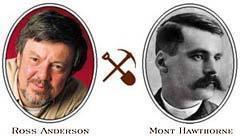
CARCROSS, Yukon Territory - "Some folks don't like water," observes Mont Hawthorne, my historical friend.
"Now me, I do. Yes sir, there's a lot to see in the Yukon country, and it's a dang sight easier to see it from a boat than it is when you're all bent over with a pack on your back."
My sentiments exactly.
The Chilkoot Trail was splendid, but punishing. So I had no qualms about climbing into the powerboat that would shuttle me and my fellow hikers down spectacular Lake Bennett to Carcross, where I would launch the next phase of my journey to the goldfields.
There is some dispute over which lake forms the headwaters of the Yukon River. For Klondikers a century ago, it was Lake Bennett. From here to Dawson City was 608 miles of lakes and river, Mother Nature's freeway to the Klondike. And it appeared to be all downhill.
Lake Bennett imposed some critical decisions over how to negotiate this last stage. The mountain passes favored loners; the lakes and river did not.
Three or four men could build and sail a bigger, stronger boat - a significant economy of scale, plus a safety factor.
Mont, two others join forces
Mont knew this. He studied the people around him, identified two, who he recalled as Gander and Wilson from Vancouver, B.C. Gander was a plasterer, Wilson a railroad man, and both looked like serious workers.
"They didn't know nothing about boat-building, so they asked me if I'd show them," Mont recalls. "We agreed to throw in together."
On May 29, 1898, the ice on Lake Bennett groaned and rumbled. Within two days, the way had been cleared through the upper lakes, which became the setting for one of the oddest flotillas in maritime history.
And they're off
Headed downstream were 7,124 boats laden with some 30,000 people and 30 million pounds of supplies. There were 20-ton scows loaded with oxen, Peterborough canoes that had been packed over the mountain passes, and everything in between.
"One was built square by a fellow who was going down alone," Mont says. "He had two sets of oarlocks, and he had put one in each side. When we passed him, he didn't seem to be making much headway frontwards.
"But the funniest boat I ever did see was one four fellows built up near us on Bennett. They had come up the Mississippi from New Orleans on an old side-wheeler, so they built their boat with two small side-wheels instead of using oars. Each wheel was on a crank, and they took turns playing engine."
Mont, meanwhile, had become the designated "captain" of a fleet of 10 men in five traditional scows and skiffs, all of which he had helped build. By the time they sailed past the Mountie station at Carcross, tradition had been vindicated: Mont's boats worked.
Carcross is a dusty native village and century-old roadhouse nestled in a spectacular northern setting. From here, one gazes across vast lakes to snow-capped mountains and a sky that seems twice the size of anything down south.
Carcross: Name said it all
For generations, it was a crossroads between Alaska, Whitehorse and the Outside World.
The Caribou Hotel, three stories of weathered planking and tin roofing, was a must stop, home to a famous parrot known for its foul vocabulary.
But the village and its native population appears to have fallen on hard times. The grand riverboat that once graced its banks burned several years ago, leaving only a charred shell.
The hotel reeks of beer and rot. At noon on a Sunday, the bar is filled with native youths drinking beer, shooting pool and mocking the tourists that climb off the tour buses for a cup of coffee.
The old railroad station has been converted into a visitor center, but the rest of the village is in disrepair. Nobody stays anymore; everybody is on the way somewhere else.
I am scheduled to rendezvous here with two kayaks, rented from a Whitehorse outfitter, and with my longtime friend, Glen Sims.
Kayak is vessel of choice
The kayak is my vessel of choice. For tradition, it is perhaps no match for Mont's hand-crafted scow, and it certainly won't haul a ton of grub to the goldfields.
But in other respects, the kayak is an even older and more appropriate vehicle. Today's fiberglass boats differ only subtly in design from what the Eskimos and Aleuts constructed from driftwood, skins and seal guts.
And, for the record, Glen is not historical. He is quite contemporary.
Like Mont, I know the value of company on the water. On the mighty Yukon, solitude is nice, but unwise.
Glen is ideal company. Over the years, we've had our share of adventures, from Puget Sound to Prince William Sound. He's a strong paddler, an instinctive problem-solver, an Irish musician and a teller of stories.
At 46, Glen's biography is not unlike Mont's. He was raised in North Carolina, headed West to escape the rigidity of the South, studied environmental management.
Now he markets cedar fencing to home-improvement stores - all to finance his habit, which is an endless fascination with the nature of the universe.
He also happens to be an outstanding cook who works wonders with a one-pound, backpacker's MSR stove.
So now we are three: Me and Mont and Glen, all headed North, trying to answer one question: Why are we doing this?